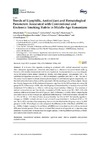Identificador persistente para citar o vincular este elemento:
https://accedacris.ulpgc.es/jspui/handle/10553/73206
| Título: | Trends of Lipophilic, Antioxidant and Hematological Parameters Associated with Conventional and Electronic Smoking Habits in Middle-Age Romanians | Autores/as: | Badea, Mihaela Gaman, Laura Delia, Corina Ilea, Anca Leasu, Florin Alberto Henriquez-Hernandez, Luis Pérez Luzardo, Octavio Luis Radoi, Mariana Rogozea, Liliana |
Clasificación UNESCO: | 32 Ciencias médicas | Palabras clave: | Cigarette-Smoking Oxidative Stress Uric-Acid Vitamin-E Eosinophil Activation, et al. |
Fecha de publicación: | 2019 | Publicación seriada: | Journal of Clinical Medicine | Resumen: | It is known that cigarette smoking is correlated with medical associated inquires. New electronic cigarettes are intensively advertised as an alternative to conventional smoking, but only a few studies demonstrate their harmful potential. A cross-sectional study was designed using 150 subjects from Brasov (Romania), divided into three groups: non-smokers (NS = 58), conventional cigarettes smokers (CS = 58) and electronic cigarettes users (ECS = 34). The aim of this study was to determine levels of some plasma lipophilic and hematological components, and the total antioxidant status that could be associated with the smoking status of the subjects. Serum low density lipoproteins (LDL) cholesterol increased significantly for ECS participants versus NS group (18.9% difference) (p < 0.05). Also, the CS group is characterized by an increase of serum LDL cholesterol (7.9% difference vs. NS), but with no significant statistical difference. The variation of median values of serum very low density lipoproteins (VLDL) was in order NS < ECS < CS, with statistical difference between NS and CS groups (34.6% difference; p = 0.023). When comparing the antioxidant status of the three groups, significant differences (p < 0.05) were obtained between NS vs. CS and NS vs. ECS. Similar behavior was identified for CS and ECS. Statistically significant changes (p < 0.0001) for both vitamin A and vitamin E were identified in the blood of NS vs. CS and NS vs. ECS, and also when comparing vitamin A in the blood of the CS group versus the ECS group (p < 0.05). When all groups were compared, the difference in the white blood cell (WBC) was (p = 0.008). A slight increase in the red blood cell (RBC) count was observed, but with no statistical difference between groups. These results indicated that conventional cigarette and e-cigarette usage promotes the production of excess reactive oxygen species, involving different pathways, different antioxidants and bioactive molecules. | URI: | https://accedacris.ulpgc.es/handle/10553/73206 | ISSN: | 2077-0383 | DOI: | 10.3390/jcm8050665 | Fuente: | Journal Of Clinical Medicine [ISSN 2077-0383], v. 8 (5), 665, (Mayo 2019) |
| Colección: | Artículos |
Citas de WEB OF SCIENCETM
Citations
9
actualizado el 08-jun-2025
Visitas
147
actualizado el 22-feb-2025
Descargas
106
actualizado el 22-feb-2025
Google ScholarTM
Verifica
Altmetric
Comparte
Exporta metadatos
Los elementos en ULPGC accedaCRIS están protegidos por derechos de autor con todos los derechos reservados, a menos que se indique lo contrario.
